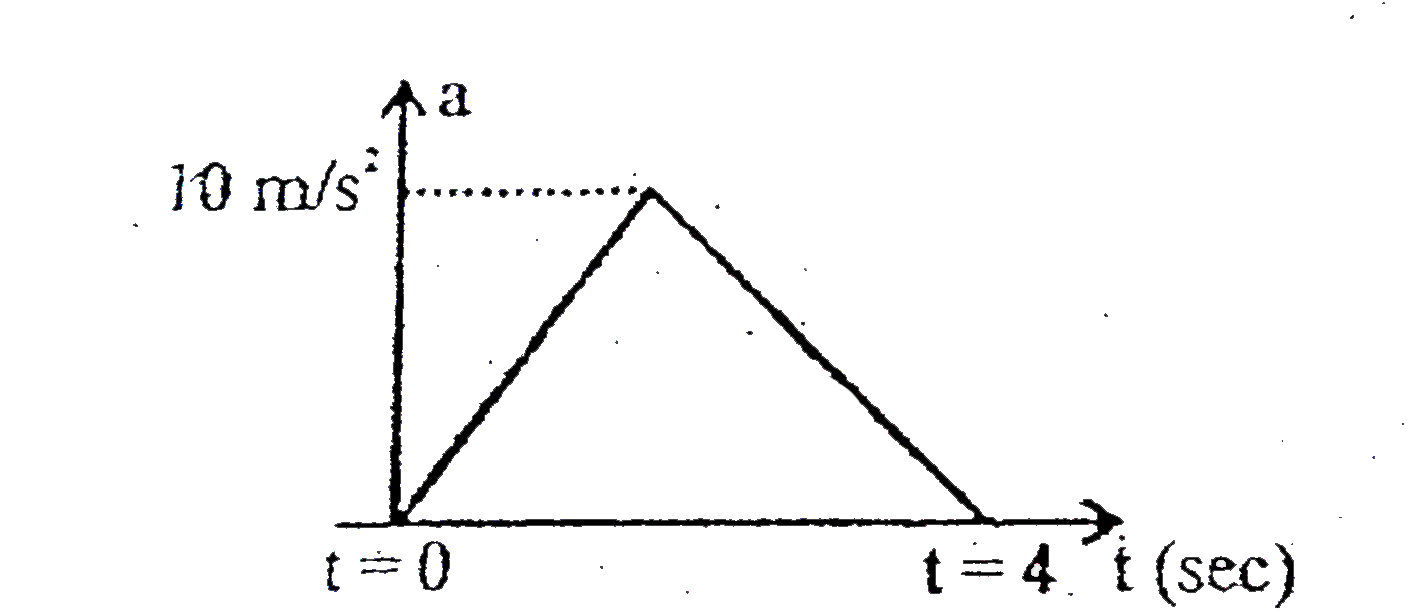The displacement (in metre) of a particle moving along X-axis is given by x=18t+5t2. The average acceleration during the interval t1=2s and t2=4s is
13ms−2
10ms−2
27ms−2
37ms−2
The correct Answer is:B
To find the average acceleration of the particle during the time interval from t1=2s to t2=4s, we will follow these steps:
Step 1: Write down the displacement equation
The displacement x of the particle is given by:
x=18t+5t2
Step 2: Differentiate the displacement to find the velocity
The velocity v is the derivative of the displacement with respect to time t:
v=dxdt=ddt(18t+5t2)
Using the power rule of differentiation:
v=18+10t
Step 3: Calculate the initial velocity v1 at t1=2s
Substituting t=2 into the velocity equation:
v1=18+10(2)=18+20=38m/s
Step 4: Calculate the final velocity v2 at t2=4s
Substituting t=4 into the velocity equation:
v2=18+10(4)=18+40=58m/s
Step 5: Calculate the change in velocity
The change in velocity Δv is given by:
Δv=v2−v1=58−38=20m/s
Step 6: Calculate the time interval
The time interval Δt is:
Δt=t2−t1=4−2=2s
Step 7: Calculate the average acceleration
The average acceleration aavg is given by:
aavg=ΔvΔt=20m/s2s=10m/s2
Final Answer
The average acceleration during the interval from t1=2s to t2=4s is:
10m/s2
The displacement x of the particle is given by:
x=18t+5t2
The velocity v is the derivative of the displacement with respect to time t:
v=dxdt=ddt(18t+5t2)
Using the power rule of differentiation:
v=18+10t
Substituting t=2 into the velocity equation:
v1=18+10(2)=18+20=38m/s
Substituting t=4 into the velocity equation:
v2=18+10(4)=18+40=58m/s
The change in velocity Δv is given by:
Δv=v2−v1=58−38=20m/s
The time interval Δt is:
Δt=t2−t1=4−2=2s
The average acceleration aavg is given by:
aavg=ΔvΔt=20m/s2s=10m/s2
The average acceleration during the interval from t1=2s to t2=4s is:
10m/s2
Topper's Solved these Questions
- BOOK - DC PANDEY ENGLISHCHAPTER - MOTION IN A PLANEEXERCISE - Check point 3.415videos
MOTION IN A PLANE
- BOOK - DC PANDEY ENGLISHCHAPTER - MOTION IN A PLANEEXERCISE - Check point 3.525videos
MOTION IN A PLANE
- BOOK - DC PANDEY ENGLISHCHAPTER - MOTION IN A PLANEEXERCISE - Check point 3.210videos
MOTION IN A PLANE
- BOOK - DC PANDEY ENGLISHCHAPTER - MOTIONEXERCISE - Medical entrances gallery19videos
MOTION
- BOOK - DC PANDEY ENGLISHCHAPTER - PROJECTILE MOTIONEXERCISE - Level - 2 Subjective10videos
PROJECTILE MOTION
Similar Questions
The displacement (in metre) of a particle moving along x-axis is given by x=18t+5t2 Calculate (i) instantaneous acceleration.
View SolutionThe displacement (in metre) of a particle moving along x-axis is given by x=18t+5t2. Calculate (i) the instantaneous velocity t=2s (ii) average velocity between t=2s to t=3s (iii) instantaneous acceleration.
View SolutionPosition of particle moving along x-axis is given as x=2+5t+7t2 then calculate :
View SolutionThe displacement x of a particle moving along x-axis at time t is given by x2=2t2+6t. The velocity at any time t is
View SolutionThe displacement of a particle along the x-axis is given by x=3+8t+7t2. Obtain its velocity and acceleration at t=2s.
View SolutionThe displacement x of a particle along the x-axis at time t is given by x=a12t+a23t2. Find the acceleration of the particle.
View SolutionThe distance traversed by a particle moving along a straight lne is given by x=180t+50t2 metre. The acceleration of the particle is
View SolutionPosition of a particle moving along x-axis is given by x=2+8t−4t2. The distance travelled by the particle from t=0 to t=2 is:-
View SolutionAcceleration time graph of a particle moving along a straight line is given. Then average acceleration between t=0 & t=4 is :−
 View Solution
View SolutionA particle moves along the X-axis as x=u(t−2s)=at(t−2)2.
View Solution

